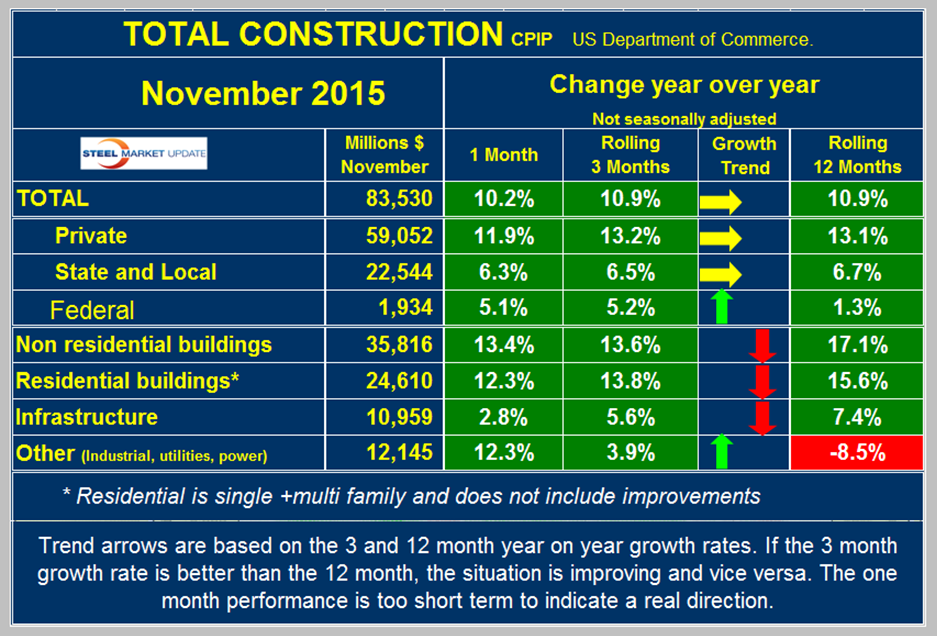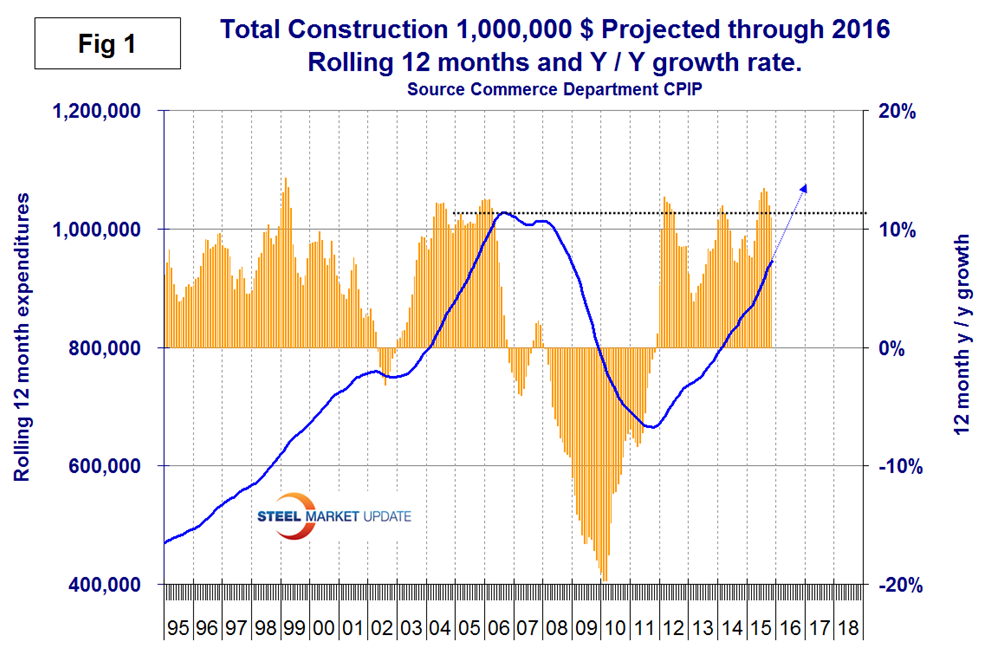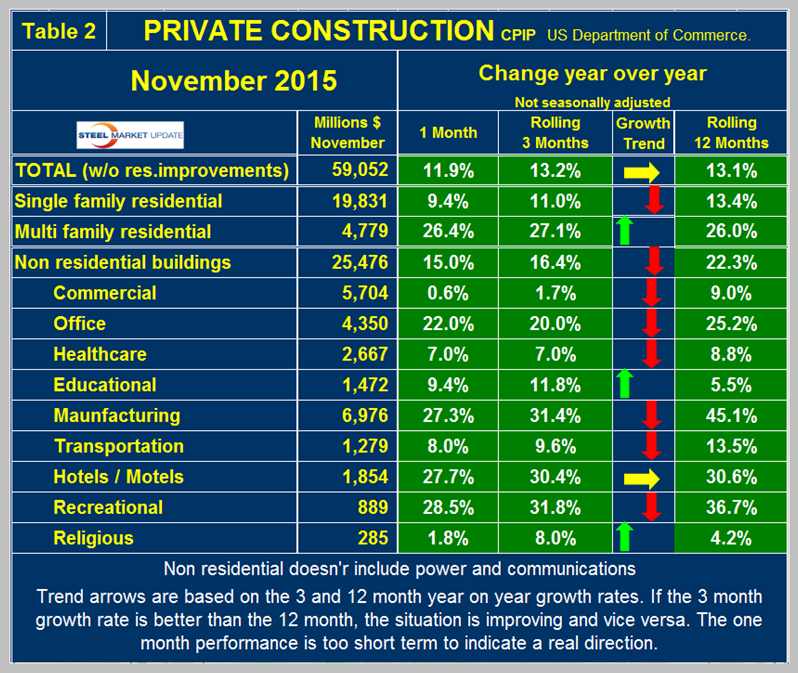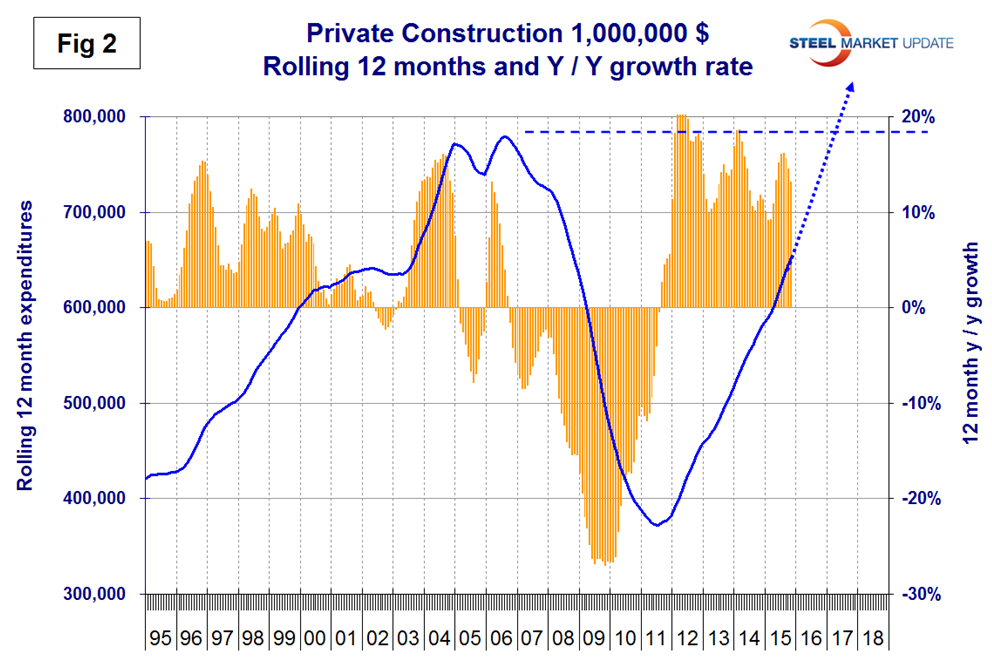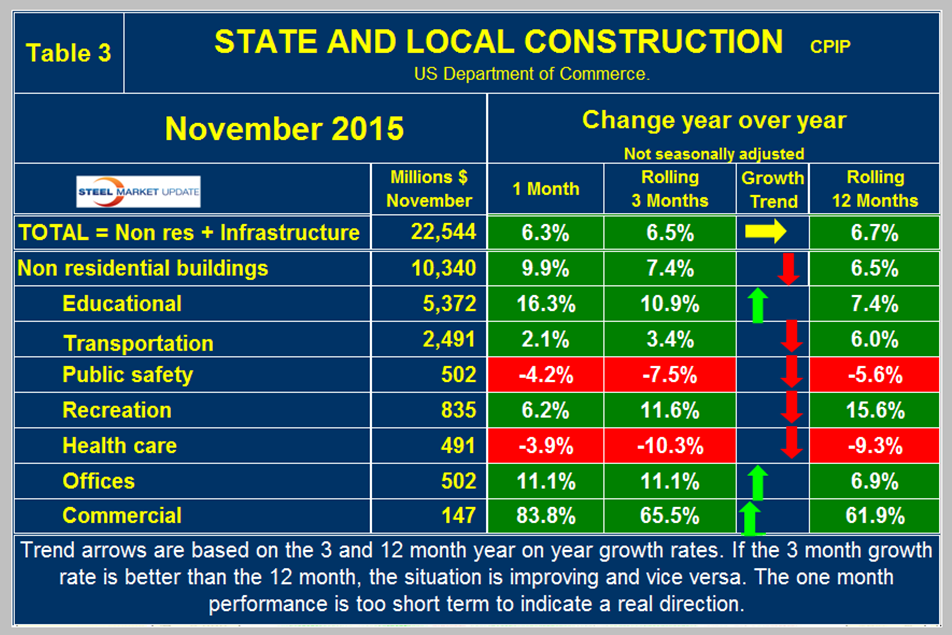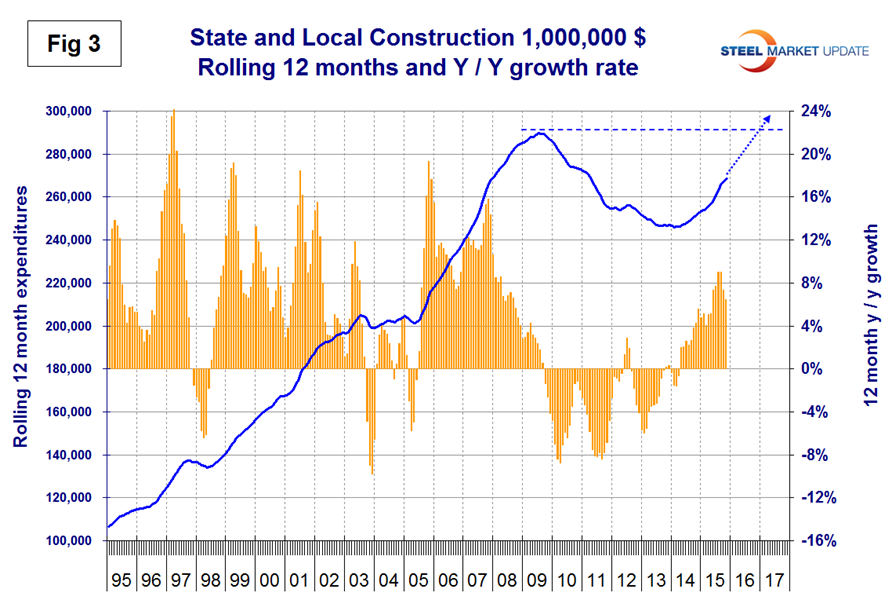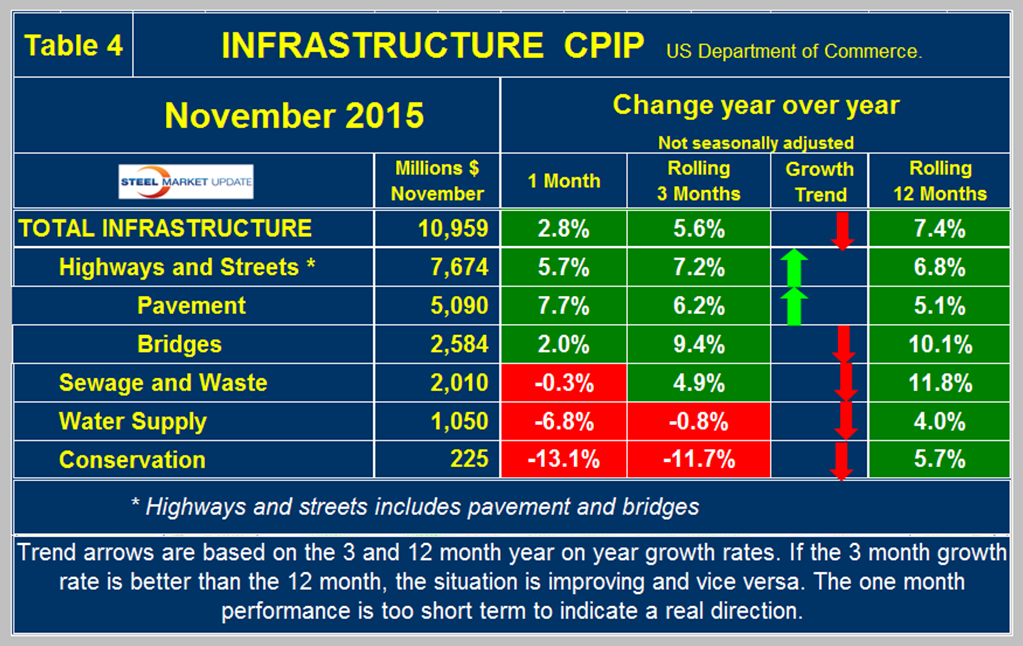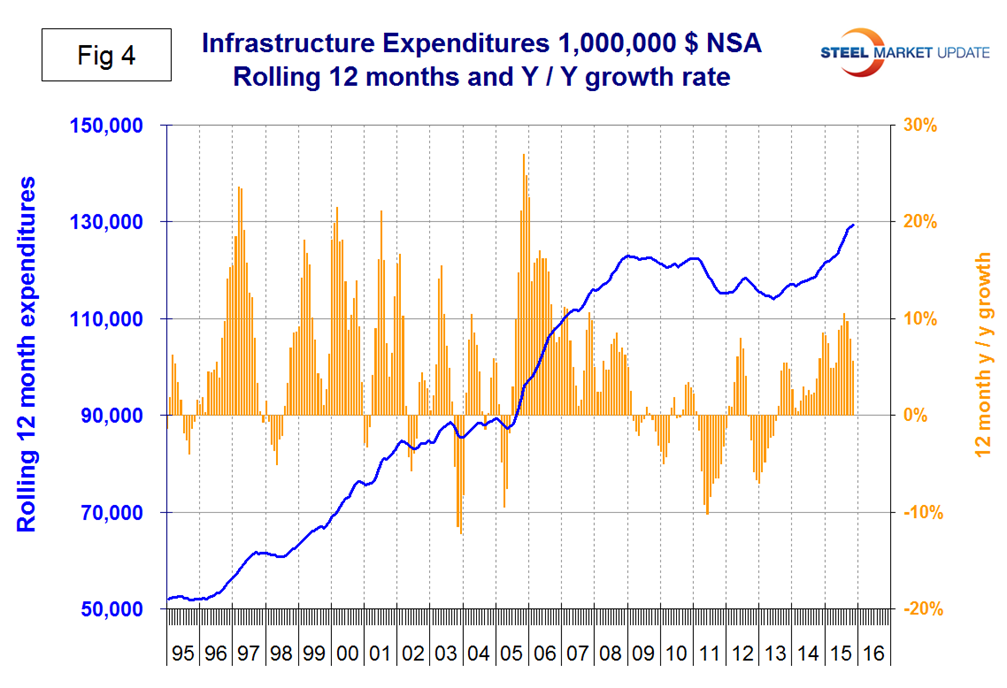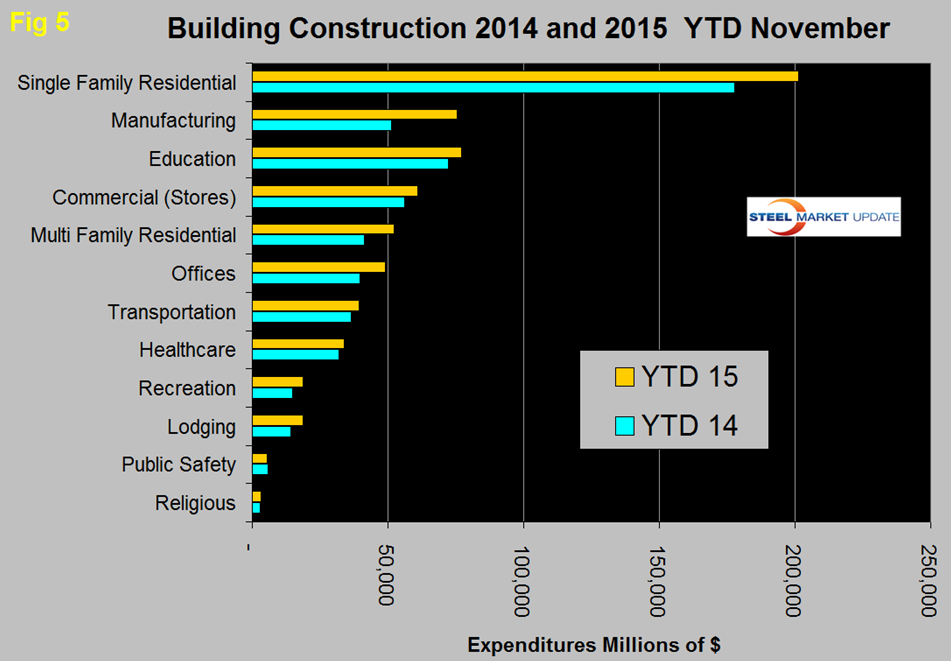Analysis

January 4, 2016
Construction Expenditures through November 2015
Written by Peter Wright
Each month the Commerce Department issues its Construction Put in Place (CPIP) data, usually on the first working day covering activity two months earlier. November data was released on Monday January 4th and data for private construction was revised back to January 2005, almost eleven years.
![]() Construction Put in Place is based on spending work as it occurs, estimated for a given month from a sample of projects. In effect the value of a project is spread out from the project’s start to its completion. This is different from the starts data published by the Commerce Department for residential construction, by Dodge Data & Analytics and Reed Construction for non-residential and Industrial Information Resources for industrial construction. In the case of starts data the whole project is entered to the data base when ground is broken. The result is that the starts data can be very spiky which is not the case with CPIP. In November there continued to be a situation where the CPIP data as we report below was very strong but the starts data is less so. Normally starts lead ongoing expenditures by six to nine months.
Construction Put in Place is based on spending work as it occurs, estimated for a given month from a sample of projects. In effect the value of a project is spread out from the project’s start to its completion. This is different from the starts data published by the Commerce Department for residential construction, by Dodge Data & Analytics and Reed Construction for non-residential and Industrial Information Resources for industrial construction. In the case of starts data the whole project is entered to the data base when ground is broken. The result is that the starts data can be very spiky which is not the case with CPIP. In November there continued to be a situation where the CPIP data as we report below was very strong but the starts data is less so. Normally starts lead ongoing expenditures by six to nine months.
At SMU we analyze the CPIP provided by the Department of Commerce with the intent of providing a clear description of activity in this steel consuming sector. Please see the end of this report for more detail on how we perform this analysis and structure the data.
Total Construction
We have reported previously that the June through October CPIP reports were excellent and on a year/year basis we find that November continued that trend. On a rolling three months basis year over year, June was up by 12.4 percent, July by 13.1 percent, August by 13.4 percent, September 13.1, October by 12.0 and November by 10.9 percent.
November expenditures were $83.5 billion which breaks down to $59.0 B of private work, $22.5B of state and locally (S&L) funded work and $1.9 B of federally funded (Table 1).
The projected date at which total construction will reach the pre-recession level is now the middle of next year (Figure 1).
On a rolling three month basis y/y total construction was up by 10.9 percent led by private work up by 13.2 percent. Total construction growth was accelerating through October but in November flattened out since the short term growth (3 months) was the same as the long term (12 months). We report this as zero momentum. Note there is no seasonality in our analysis because we only report year over year results. Federally financed work had positive momentum in 3 months through November but private and state and local were flat. On a rolling 12 month basis Federal construction declined every month for 43 months with September’s report being the first to reverse that trend with a positive 1.3 percent growth rate followed by October at + 1.7 percent and November at +1.3 percent. We consider four sectors within total construction. These are non-residential, residential, infrastructure and other. The growth rate of non-residential buildings, residential buildings and infrastructure are good but all three have negative momentum. The growth rate of “other” which mainly consists of industrial, utilities and power projects became very negative at the time of the oil price collapse a year ago but has recovered to positive growth in the last three months on a 3MMA basis. Infrastructure grew 5.6 percent in three months through November year over year with negative momentum and other grew by 3.9 percent with a very positive momentum. The growth rate of total construction slowed in the first three months of this year but improved at a double digit rate every month since then as shown by the brown bars in Figure 1. The pre-recession peak of total construction on a rolling 12 month basis was $1,145 B in 12 months through February 2007. The low point was $665.1 B in 12 months through October 2011. The 12 month total through the latest data of November 2015 was $945.7 B. July through November were the first months to exceed $900 B since April 2009 when the recession was gaining traction.
Private Construction
Table 2 shows the breakdown of private expenditures into residential and non-residential and subsectors of both.
The growth rate of private construction was 13.2 percent in the last three months as shown by the brown bars in Figure 2.
The blue lines in all four graphs in this report are 12 month totals which smooths out seasonal variation. Excluding property improvements our report shows that both single and multi-family residential continue to have strong y/y growth but single family has negative momentum. The single family expenditures reported here have a rate of growth higher than that of the Census Bureau housing starts data which have a growth rate of 9.2 percent. The growth of starts being lower than current expenditures we are discussing here suggests some further slowing growth going forward. The growth of multifamily expenditures in this CPIP report is very much higher than construction starts of this sector reported by the Census Bureau. In this CPIP report multi family is growing at 27.1 percent as the multifamily housing starts data from the Census Bureau is growing at 13.3 percent. Private non-residential building expenditures grew at a solid 16.4 percent in three months through November y/y with negative momentum. Within private non-residential, all sectors had positive growth led by recreational, accommodation, offices and manufacturing however all but two had either negative or flat momentum. Nonresidential starts data published by Dodge Analytics had a double digit negative growth rate year over year in the three months September through November.
State and Local Construction
S&L work expanded by 6.5 percent in the rolling three months through November y/y with flat momentum (Table 3).
June through November had the highest growth rates for S&L construction since before the recession. Figure 3 shows year over year growth as the brown bars.
Educational buildings are by far the largest sub sector of S&L non-residential at $5.372 billion in November. Recreational buildings have accelerated markedly in the first 9 months of 2015 and grew by 11.6 percent in the latest data. This includes convention centers, sports arenas, theatres and miscellaneous amusements. Table 2 shows that S&L health care expenditures contracted by 10.3 percent but $491 million is much less than the $2.667 billion of private healthcare expenditures which grew at 7.0 percent. August was the first months for public safety buildings which includes jails, police, courthouses and fire stations to have positive growth after 32 straight months of contraction. September through November reverted to contraction for this sector. Comparing Figures two and three it can be seen that S&L construction did not have as severe a decline as private work during the recession and that at first private work bounced back faster. S&L expenditure growth has now recovered to the point that at the present rates both sectors will exceed the pre-recessionary peaks within 18 months.
Drilling down into the private and S&L sectors as presented in Tables 2 and 3 shows which project types should be targeted for steel sales and which should be avoided. There are also regional differences to be considered for which data is not available from the Commerce Department. In December 2015 the Bureau of Labor Statistics initiated the reporting of GDP data by state and by sector, including construction and when the next update is released in March we will initiate a routine analysis for our subscribers.
Infrastructure
Expenditures have had positive growth every month since July 2013 with a +5.6 percent result in the latest data with negative momentum. Highway and streets including pavement and bridges accounts for about 2/3 of total infrastructure expenditures and had positive growth for 15 months through February, contracted in March and April then had positive growth ever since culminating in a 7.2 percent rate in three months through November. Highway pavement is the main subcomponent of highways and streets and had a 6.2 percent positive growth in three months through November. Bridge work contracted every month in the period August through November 2014 but has since expanded every month with an accelerating trend. Bridge work totaled $2.6 billion in the single month of November with a strong 9.4 percent growth rate (Table 4).
Infrastructure expenditures were slow to respond to the recession due to the magnitude of many of these projects. Growth stopped in 2009 and 2010 but it wasn’t until 2011 that an actual contraction occurred. For most of 2015 infrastructure expenditures have exceeded the pre-recession high (Figure 4).
Total Building Construction Including Residential
Figure 5 compares YTD expenditures for building construction for 2014 and 2015.
Single family residential is dominant and through November 2015 totaled over $201 billion. On this year over year basis the only sector to be trailing 2014 is public safety which is down by 5.7 percent, at the other extreme manufacturing is up by 47.5 percent.
Explanation: The official CPIP press report gives no appreciation of trends on a historical basis and merely compares the current month with the previous one on a seasonally adjusted basis. The detail is hidden in the published tables which we at SMU track and dissect to provide a long term perspective. Our intent is to provide a rout map for those subscribers who are dependent on this industry to “Follow the money.” This is a very broad and complex subject therefore to make this monthly write up more comprehensible we are keeping the information format as consistent as possible. In our opinion the absolute value of the dollar expenditures presented are of little interest. What we are after is the magnitude of growth or contraction of the various sectors. Data is reported by the Commerce Department on both a seasonally adjusted and non-adjusted basis. Their official commentary is based on adjusted numbers. In the SMU analysis we consider only the non-seasonally adjusted data because we don’t trust seasonal adjustments and in any case our businesses operate in a seasonal world. We eliminate seasonal effects by comparing rolling three month expenditures year over year. CPIP data also includes the category of residential improvements which we have removed from our analysis in the rational that such expenditures are minor consumers of steel.
In the four tables above we present the non-seasonally adjusted expenditures for the most recent month of data. Growth rates presented are all year over year and are the rate for the single months result, the rolling 3 months and the rolling 12 months. The arrows indicate momentum. If the rolling 3 month growth rate is stronger than the rolling 12 months we define this as positive momentum and vice versa. In the text, when we refer to growth rate we are describing the rolling 3 months year over year rate. In Figures 1 through 4 above the blue lines represent the rolling 12 month expenditures and the brown bars represent the rolling 3 month year over year growth rates.



